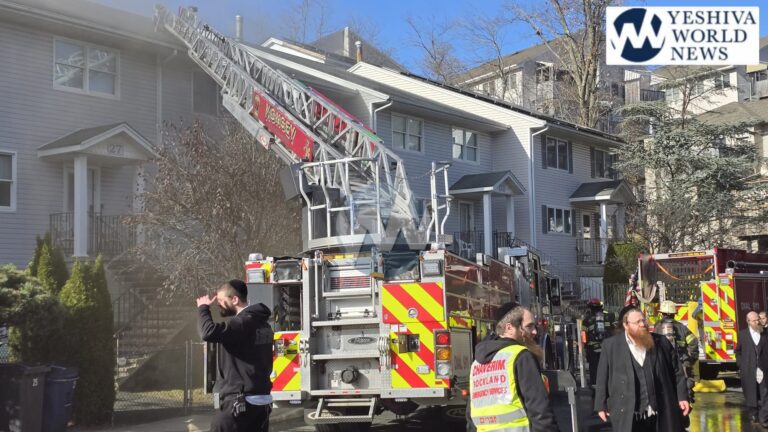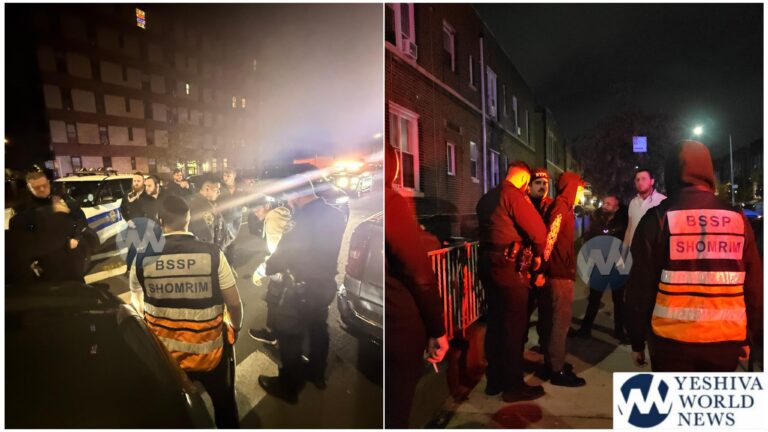 By Rabbi Yair Hoffman for the Five Towns Jewish Times
By Rabbi Yair Hoffman for the Five Towns Jewish Times
Jimmy Kimmel is a catholic-born comedian who hosts a late-night comedy show. One of his routines, apparently, features a social experiment entitled “How Long.” Essentially, scenarios are set up to see how long it will take for members of the public to react.
THE VIDEO
In one recent episode, the Sponge Bob character falls down on a busy sidewalk on Hollywood Blvd and the experiment is how long it takes for someone to come to his assistance. The episode was watched by some 64,000 Youtube viewers. In this episode, some six minutes and forty seven seconds elapse until a group of high school aged Yeshiva students help Sponge Bob up. In the meantime, people take pictures of the poor Sponge Bob, others jump over him, but hundreds ignore him.
After the Yeshiva students lend him assistance, Sponge Bob dances with the Yeshiva students and begins to sing “Hava Nagilah.” While it is a curious irony that Yeshiva students probably do not know the words to “Hava Nagilah” while Sponge Bob and the Catholic Jimmy Kimmel do, that is not the point of this article.
There is no question that the actions of these young men constitute a remarkable Kiddush Hashem. Blessed are the mothers of these young men, and fortunate is the Yeshiva who educated them. These young Yeshiva students fulfilled the Mitzvah of “Lo sa‘amod al dam rei‘echa”—“Do not stand idly by your neighbor’s blood” (Vayikra 19:16). The Ramban (Hosafos, Mitzvos Asei 16) as well as the Meiri (Sanhedrin 58a) rules that this verse applies to all people.
THE DISTURBING COMMENT
We move now to a comment made on one of 5TJT.com’s competitor websites. The commenter wrote:
“Costumed character are often worn by females.For bochurim (or boys over 9 years old) to touch, hug or hold a costumed character – can be very ossur!
This is NOT a case of pikuach nefesh when only a chossid shoteh refuses to save a drowning female. That is called in shulchan oruch “a chossid shoiteh” – which is the same term used in shulchan oruch for someone eating in sukkah during rain downpour…”
THE HALACHA
The Gemorah in Sotah 21b discusses what is referred to as a Chossid Shoteh – a “righteous” fool. The example given is when a person refuses to save a woman drowning in a river because he feels it is inappropriate to look upon her. The commenter on the website states that the Gemorah in Sotah only refers to a case of Pikuach Nefesh. However, it is not so simple that this is the case.
What is the Halacha when a woman falls upon the ground?
Firstly, it should be known that whenever someone falls there is always a chance of internal injuries. There is also the underlying reason for the initial fall which could also be Pikuach Nefesh.
But aside from this, the custom is, when medically necessary, to rely upon the Shach’s view (YD 195:20) that touching a member of the opposite gender in a manner that is neither affectionate nor desirous is not prescribed wither biblically or Rabbinically. This is also the view of the Munkatcher Rebbe (Darchei Teshuva YD 195:56) regarding touching a woman’s eye.
When not done for medical purposes or for great need, Poskim have written that it is considered mechuar – unseemly (but technically not Rabbinically forbidden). This is the view of the Chavos Yair (#182) and the Pnei Yehoshua (Responsa Vol. II #44).
Others (Aizer MiKodesh EH 20:1) write that, in fact there is a Rabbinic prohibition even when the touching is done in a non-desirous and non-affectionate manner. But this prohibition is lifted when it is done for medical necessity.
The issue was addressed in a responsa by Rav Binyamin Zilber zt”l (Az Nidberu Vol. XIV #51) dated January 18th, 1986. Rav Zilber concludes that when it is done to assist someone who has been injured and not in a manner of “derech taava – desire” it is permitted. He does advise that the Fifth Shulcha Aruch be used – i.e. seichel and prudence.
We can conclude that when someone has fallen down and the issues of basic human decency in rendering assistance come to the fore, there is no question that it should be rendered immediately. If someone does not do so, the appellation of Chasid Shoteh should be applied. This is the conclusion of Rav Zilber zt”l.
THE BYSTANDER APATHY
Unfortunately, the Kimmel video, however, is somewhat reminiscent of the Kitty Genovese story.
On March 13, 1964, a young Queens woman was brutally stabbed to death. Her assailant had chased her and attacked her three times on Austin Street in Kew Gardens while 38 of her neighbors watched from their windows. According to a New York Times report, not one of the 38 neighbors bothered to call the police until 35 minutes had elapsed. Kitty Genovese, the Queens woman, died because help was not called for in time.
Abe Rosenthal, who would later become the editor of the New York Times, wrote a book about the Kitty Genovese case. He attributed the neighbors’ apathy to a “big city” phenomenon, where ignoring others is crucial to the psychological survival of its residents. In his book, Rosenthal wrote, “Indifference to one’s neighbor and his troubles is a conditioned reflex in life in New York.”
Perhaps backing up Rosenthal’s theory is the notion alluded to in the Tosefta that city people somehow are different than out-of-town people. The Tosefta in Kiddushin (2:2) states that if a person purported to be a town dweller and he was really a city dweller, the marriage he had contracted is invalidated. Ostensibly, the Tosefta chose this illustration because there is a qualitative difference between city people and non-city people. Does this Tosefta indicate something about the mindset of people that live in an urban dwelling? Perhaps. It is not just 1960’s New York – the busy streets of Hollywood certainly embody this mindset as well.
Notwithstanding A. M. Rosenthal’s assertion, however, there is perhaps another explanation. This second explanation could be best understood through a very famous Yiddish story about a small European shtetl. Only ten men lived in the shtetl, but it boasted a shul where there was a minyan for Shacharis, Minchah, and Maariv every day for ten years in a row. The town was famous across the entire country. So famous, in fact, that an eleventh man moved into the neighborhood. What transpired next?
The next day, no one showed up in shul.
RAV KARO MAY BE DEALING WITH BYSTANDER APATHY
It may be suggested that the author of the Shulchan Aruch, Rav Yoseph Karo, was well aware of this phenomenon, as can be seen from a fascinating halachah in the laws of treating a sick person on Shabbos (O.C. 328:15).
ALL SHOULD GO
The ruling is that when doctors determine that a sick person on Shabbos requires a certain medicine, and ten people go to retrieve that medicine (in the Gemara’s case, it involved plucking a fig from a tree), all ten are patur (not liable for violating the Shabbos). The Shulchan Aruch, however, adds seven fascinating words that appear neither in the Gemara nor in the Rambam’s reformulation of the ruling. The Shulchan Aruch adds, “V’kulam yesh la’hem sachar tov me’eis Hashem”—“And all of them have a good reward from Hashem.”
The Ma’amar Mordechai, one of the classical commentaries of the Acharonim on the Shulchan Aruch, explains that the Shulchan Aruch was concerned that the bystanders may not act quickly; he therefore added this clause to ensure that all ten actually would retrieve the medicine.
In the 1970s, two New York City psychologists performed some startling experiments (Latané and Darley of Columbia University and NYU, respectively; see B. Latané & J. Darley, The unresponsive bystander: Why doesn’t he help? New York: Appleton-Century-Crofts, 1970). They faked emergencies in front of various people to see what the reactions of bystanders would be. In one case, they had a college student alone in a room stage an epileptic fit. When there was just one person next door, the response rate of calling for help was 85%. Yet, shockingly enough, when there were four others who also witnessed the college student’s epileptic seizure, the response rate was only 35%.
In a second experiment, Latané and Darley caused smoke to seep out from under a doorway, both in front of individuals as well as in front of people in a group. When alone, a bystander would report the smoke 75% of the time. When in a group, the bystanders reported the smoke only 38% of the time. It seems clear that when bystanders think that someone else is taking care of a situation, they are less apt to respond appropriately.
According to the Ma’amar Mordechai, this was the intent of the Shulchan Aruch. The Shulchan Aruch was well aware of this tendency within man to either assume that a situation is already taken care of by others or to assume that the problem isn’t really a problem when there are other people there, too. He addressed this issue by indicating to all that they all have tremendous merit from Hashem in responding.
HATZALAH DRIVERS
The issue may have yet another corollary. There is a well-known debate among halachic authorities about whether a Hatzalah driver can return home after he responds to a call on Shabbos. Rav Moshe Feinstein (Igros Moshe, O.C., Vol. IV No. 80) rules that Hatzalah volunteers may drive back, while Rav Shlomo Zalman Auerbach (Minchas Shlomo 1:8) rules that they may not.
The debate may hinge upon whether there exists another type of bystander apathy. Is there a concern that if the volunteer knows he cannot drive back, he may not choose to respond quickly? Might his lack of a ride back affect his judgement as to whether to go out in the first place? Rav Moshe Feinstein, zt’l, held that it might affect him, while Rav Shlomo Zalman Auerbach, zt’l, held that it most certainly would not. Those communities that follow Rav Shlomo Zalman’s view therefore employ a gentile to drive the volunteers back. The communities that follow Rav Moshe’s view allow the Hatzalah volunteers to drive back themselves. We can conclude from these discussions that both Rav Moshe Feinstein and the Ma’amar Mordechai posit the existence of a kind of bystander apathy that must be addressed.
In conclusion, society owes these young Yeshiva students a debt of gratitude. They exemplify the highest ideals of what people should be doing – lending assistance to others and fighting bystander apathy.
The author can be reached at [email protected]











21 Responses
Thank you Rabbi for a great article!
Very interesting and informative,thorough and fair as always.
Of note is the almost as an aside note that there is a difference between “in town” and “out of town” people to the point that the facts, once revealed, could invalidate a shidduch/kiddushin.
Is it, therfore, so farfetched that the often fundamental difference in personality between those who use plastic on their tables, eat off of paper, or come to the table (or even walk out) wearing a robe are fair reasons to refuse a proposed shidduch?
great article. amazing how rabbi hoffman put it together so soon after the video went viral. i was a little surprised that rabbi hoffman omitted Igros Moshe Even Haezer, beis, yud daled.
Could there be a possible flaw in the social experiment namely that the attire of the person flailing on the ground was that of a childish cartoon character rather than that of a normal person, thus leading most people to (correctly) believe that the whole thing was nothing more than a stunt?
I thought the whole time it was Faivish of Oorah fame and that’s why the boys picked him up.And next years 5 dollar raffle will include tickets to the Jerry Kimmel show.
“… not prOscribed, whether,” not “… not prescribed wither.” It could be due to autocorrection. Good article.
Nice article but I wonder if it’s correct.
Lo Saamod Al Dam Reiecha, is stated when indeed the other person is in trouble. Here it was staged.
Furthermore, even if you argue that there was no way for these students to know that it was staged (which I don’t think is true) even so, it may not qualify as Lo Saamod…because ultimately that mitzvah was not performed.
Suppose someone purchased a verified esrog for sukkos from a reputable esrog grove. After sukkos he chops it up and lo and behold its a lemon. Did he get a mitzvah of shaking a lulov & esrog that year? No. Did he sin? No, because Ones Rachmana Patrei, but he certainly did not accrue a positive mitzvah of esrog.
Here too, the actor was NOT in a state of harm at all. So you can not say that the mitzvah of Lo Samod…took place. Furthermore, they probably knew that it was a fake. It’s sponge bob yelling out in a funny voice for help…or they should have known if they thought about it for a minute.. so even if you argue that its based on what they think, not the reality, (which I do not think is correct) even so, that would not be the case here.Since it’s rather obvious that its staged
And that could explain why so many people ignored sponge. Perhaps they share the city mentality, perhaps they are in their own world, but i’m sure many people readly understood that its a joke.
This is what I think, would like to here what others and the author have to say to this.
I appreciate this article very much – the article itself is a kiddush Hashem.
Let’s have even more articles about bein adam l’chaveiro.
Thank you, R’ Hoffman.
Can Yair Hoffman address how the halacha (including providing sources/maare makoms) fits in when the person who fell is a nochri or a non Shomer Mitzvos? (And given that acting in a cartoon character on the streets of Times Square is highly unusual for a shomer mitzvos.) Thanks
Just to follow-up my above comment #9: In the above comment I am specifically referring to a situation where their is a 50/50 possibility that the costumed character may be of either gender. And the issue is helping the person stand up.
What is particularly impressive is the instictive knee-jerk reaction. Somebody needs help, their bodies are programed to jump into action!
בני אברהם אבינו
#7 Jewishness – you are missing the point here. The main point here was an example of שלשה סימנים יש באומה זו הרחמנים והביישנין וגומלי חסדים
I believe that what Rav Hoffman was trying to show is that נגיעה was not a חשבון here. Although he did not say outright, it seems to me that first of all there is 1) a ספק אשה and even if it was a women 2) the האסור נגיע doesn’t necessarily apply here being that these boys were certainly not touching מתוך תאוה.
Your comparison does not apply here being that the mitzva of lulav and etrog is reliant on the kashrut of the etrog, while over here it it is based on איסורי מחשבה, which they clearly did not have.
#9 Will Hill – Your comment starts out faulty by your lack of respect when addressing an ordained “kosher” Rav and rolls down hill from there. I suggest you reevaluate your priorities in life with a competent Rav and start speaking to others with more respect.
Mr. Softwards #13. Consider rabbi to be added to the title. (I hadn’t been aware the author was a pulpit serving rabbi. And didn’t notice the title in the article when authoring the questions.)
If you have anything substantive to add or respond to the questions posed in #s 9 & 10, feel free to contribute something useful towards the Halachic discussion. Comments #9 and #10 are entirely based on Halacha and not personal feelings.
For #9
“These young Yeshiva students fulfilled the Mitzvah of “Lo sa‘amod al dam rei‘echa”—“Do not stand idly by your neighbor’s blood” (Vayikra 19:16). The Ramban (Hosafos, Mitzvos Asei 16) as well as the Meiri (Sanhedrin 58a) rules that this verse applies to all people.”
Btw, A man that eats in a Sukkah during a downpour is titled in the Gemara as a “Hedyot”. Not a “Chossid Shoteh”.
p.s.
IMHO, the issue of the possibility that this SpongeBob was a female is a moot point.
It’s most likely that these boys, and also the rest of us, will never know the gender of the person in the costume.
(So anyway there is virtually little or no chance of resulting lurid thoughts.)
Combine that with the Kiddush Hashem… it’s practically a no-brainer.
(The boys didn’t know they were going to be on national T.V. but there were many bystanders.
Plus, they did the right thing even if the street would have been deserted!)
ydf #15: That isn’t the normative accepted psak for what “rei‘echa” means. The accepted psak is it is referring to our own.
Accepted p’sak? Can you quote sources?
Have seen the piece on “V’ahavta l’rei’acha kamocha” from the P’ri Eitz Hadar?
Sorry P’ri Eitz Chaim. My mistake.
lo saamod al dam rei’echa has always been understood to mean brother or yehudi only. See Sanhedrin 73a.
Also see the Yalkut Yosef, Bikur Cholim, p. 60 why lo saamod al dam rei’echa wouldn’t apply in the above case.
ydf: Is the Shulchan Aruch an acceptable enough psak? See S”A Choshen Mishpat 425, based on Gemara Avoda Zara 26b. Specifically, the halacha regarding מורידין ולא מעלין and leaving a non shomer in a pit without assisting.